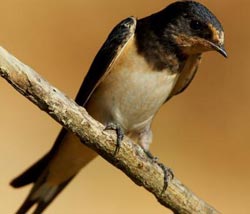Chernobyl's radioactivity reduced the populations of birds of orange plumage

Bird populations fell as the levels of radiation in peripheral zones of Chernobyl (Ukraine) rose. Credit: Rafael Palomo Santana<br>
Radiation causes oxidative stress, damages biological molecules and may have “important” negative effects on organisms in relatively high doses, like those found in certain zones close to Chernobyl.
“In the case of the birds studied, these effects were seen in the size of their populations”, says Ismael Galván, lead author of the study and researcher in the Laboratory of Ecology, Systematics and Evolution at the University of Paris-Sur, in France, speaking to SINC.
According to the study, which has been published in the journal Oecologia, bird populations fell as the levels of radiation in peripheral zones of Chernobyl (Ukraine) rose. In total, the researchers analysed the abundance of 97 bird species exposed to different levels of radiation during four years.
In the majority of the birds (64 species), the populations diminished with the level or radioactivity. “Nevertheless, the populations of a few species (the 33 remaining species) experienced positive effects from the radiation (though the magnitude of these effects was very low in some cases), perhaps due to the reduction in competition with other species”, explains Galván.
Colour: a bird's weak or strong point
The scientists concentrated on the colouring generated by melanins – pigments which protect from ultraviolet radiation and generate camouflage patterns – of the nearly one hundred species of bird studied. The reason: the type of pigmentation may interfere with the ability to resist radioactivity's negative effects.
“The impact on the populations depends, at least in part, on the amount of plumage whose colouring is generated by pheomelanin, one of the two main types of melanins, which produces orangish and brownish colours”, the Spanish expert adds.
The birds of Chernobyl with the most pheomelanism (with the most plumage coloured by pheomelanin) were judged to be the “most negatively” affected by the radioactivity. As the pigment consumes glutathione (one of the antioxidants most susceptible to radiation and whose level tends to be diminished by its effects), in these birds, the capacity to combat the oxidative stress generated by radiation “probably” diminishes.
References:
Galván, Ismael; Mousseau, Timothy A.; Moller, Anders P. “Bird population declines due to radiation exposure at Chernobyl are stronger in species with pheomelanin-based coloration” Oecologia 165(4): 827-835, april of 2011.
Media Contact
More Information:
http://www.plataformasinc.esAll latest news from the category: Ecology, The Environment and Conservation
This complex theme deals primarily with interactions between organisms and the environmental factors that impact them, but to a greater extent between individual inanimate environmental factors.
innovations-report offers informative reports and articles on topics such as climate protection, landscape conservation, ecological systems, wildlife and nature parks and ecosystem efficiency and balance.
Newest articles

Silicon Carbide Innovation Alliance to drive industrial-scale semiconductor work
Known for its ability to withstand extreme environments and high voltages, silicon carbide (SiC) is a semiconducting material made up of silicon and carbon atoms arranged into crystals that is…

New SPECT/CT technique shows impressive biomarker identification
…offers increased access for prostate cancer patients. A novel SPECT/CT acquisition method can accurately detect radiopharmaceutical biodistribution in a convenient manner for prostate cancer patients, opening the door for more…

How 3D printers can give robots a soft touch
Soft skin coverings and touch sensors have emerged as a promising feature for robots that are both safer and more intuitive for human interaction, but they are expensive and difficult…





















